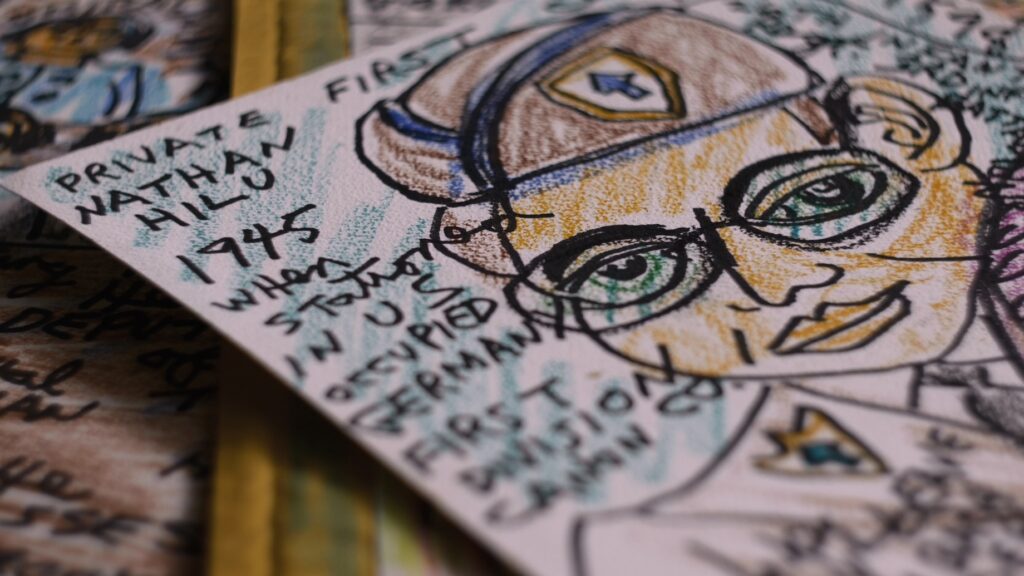A Devastating Documentary, ‘Nathan-ism’ Focuses on a Witness to History at Nuremberg
When we meet Nathan Hilu, the nonagenarian artist is drawing, scribbling, cutting, pasting, and writing about the time he spent at Nuremberg. A lively raconteur, he rattles off his adventures with a ragged and often salty esprit.

Elan Golod’s “Nathan-ism,” a documentary set to open Thursday at Greenwich Village’s Quad Cinema, is a gripping and, in significant ways, devastating film, an entertainment that all but belies the word. That Mr. Golod’s movie concerns the Nuremberg trials accounts for much of its psychological heft, but so, too, does its focus on memory.
At a time when the distinction between objective fact and subjective interpretation is often rendered tenuous or nugatory, the appearance of such a film unsettles. Mr. Golod’s movie treads upon restive ground.
The subject of “Nathan-ism” is a descendant of Syrian Jews, Nathan Hilu (1925-2019). Born on Manhattan’s Lower East Side, Hilu grew up at Pittsburgh, where he was, according to arts journalist Jeannie Rosenfeld, raised in “the community’s dominant Ashkenazi traditions.”
Upon turning 18 in 1943, Hilo joined the Army — largely, he insisted, to escape a domineering father who disapproved of his son’s artistic inclinations. After being stationed in France and Germany, Hilu worked as part of the security forces guarding Nazi war criminals at Nuremberg.
Did General George S. Patton really encourage the young soldier to pursue a military career, given the abundance of Jewish lawyers and doctors in the U.S.? Hilu studied Japanese and Russian through the auspices of the U.S. Army, served in the Korean War, and worked for the Counter Intelligence Corps at Tokyo.
Upon leaving the Armed Forces, Hilu returned to New York City and began working in the book trade, ultimately catching the eye of Harry N. Abrams. The art-book publisher provided drawing materials for Hilu as well as monographs devoted to painters like Marc Chagall and Salvador Dali. We get passing glimpses of Hilu’s early Judaica in drawings that bear a resemblance to the late work of an American modernist, Max Weber. They’re scrabbled, energetic, and riddled with yiddishisms.

The majority of pieces featured in “Nathan-ism” were made during the last decade or so of Hilo’s life, most of them rendered in Sharpie and embellished with crayon. When we meet the nonagenarian artist he’s drawing, scribbling, cutting, pasting, and writing about the time he spent at Nuremberg. He’s a lively raconteur, our Nathan, and rattles off his adventures with a ragged and often salty esprit. The self-stated “poor Jewish schlepper” has stories to tell.
And tell them he does, primarily through innumerable works-on-paper but also in words that are equally rambunctious in character. Hilu recounts kicking the “tuchus” of the chief of Reich security, Ernst Kaltenbrunner, as he made the way to his execution. He had far-ranging conversations with the architect, Albert Speer. As for the final days of Hermann Göring, Nathan insists that he knows how Hitler’s right-hand man obtained the potassium cyanide to commit suicide, thereby eliding the indignity of the gallows. All of which is set out in Hilu’s work.
“Nathan-ism” takes a distinct turn away from Hilu’s creative output and its relative artistic worth into territory that is less concrete and considerably more variable. We watch as a cadre of experts — curators, journalists, historians, a former director of the Office of Special Investigations at the U.S. Department of Justice and Mr. Golod himself — reckon with the discrepancies that can accrue between the exigencies of art and the needs, often unbidden, of man who was a witness to history.
Mr. Golod has made an engrossing film, but the story it relates is complicated, contradictory, and, in the end, humbling. There are myriad reasons you’ll not soon forget Nathan Hilu.

